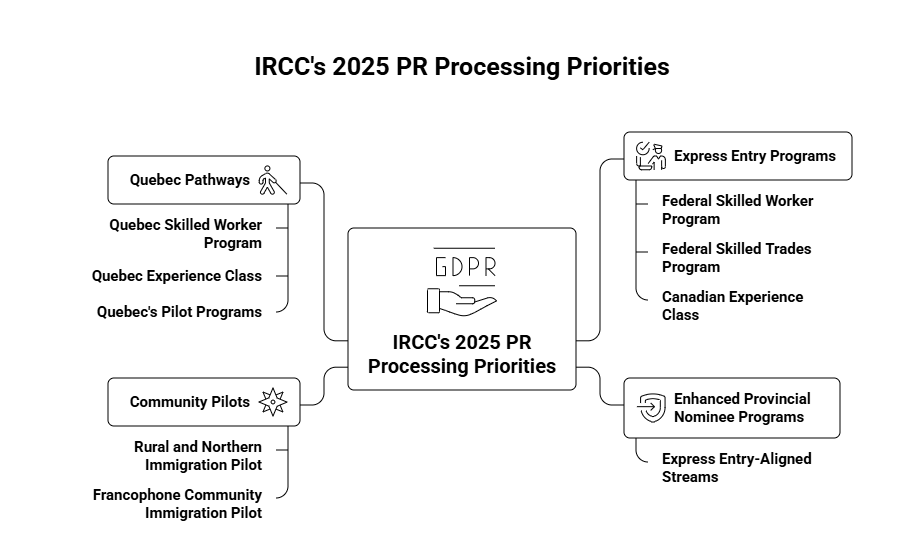Posted on October 09 2025
IRCC Confirms Which PR Streams Will Be Prioritized in 2025. Check your eligibility!
By , Editor
Updated October 09 2025
Highlights: IRCC 2025 Plan Reveals Fastest PR Streams for Applicants
- IRCC has outlined its 2025 PR processing plan, confirming that only select programs will see their entire inventory cleared this year.
- Express Entry and aligned PNP streams top the list, with 100% of applications to be processed by the end of 2025.
- Federal Skilled Worker (FSW) and Canadian Experience Class (CEC) programs will maintain steady 5–6 month average processing times.
- Base PNP and Atlantic Immigration Program (AIP) will see only 33–35% of files finalized due to higher pending volumes.
- Caregiver and Start-up Visa programs face major delays, while Quebec Skilled Worker pathways will clear all pending applications this year.
*Want to check your eligibility to Canada? Try out the Y-Axis Canada immigration points calculator to get an instant score!
IRCC Announces Key PR Pathways to Be Cleared in 2025
In its 2025 plan, Immigration, Refugees and Citizenship Canada (IRCC) has outlined the PR streams that will receive full processing priority this year. These programs have been chosen for their strong contribution to Canada’s economy, labor market, and regional growth goals.
IRCC’s focus remains on pathways that bring skilled professionals, experienced workers, and community-based talent into the country — supporting industries facing labor shortages and helping provinces meet immigration targets.
The priority list includes some of Canada’s most popular PR programs, such as Express Entry, Provincial Nominee Programs (PNP) aligned with it, Quebec’s Skilled Worker pathways, and federal community pilots. These will have their entire application inventories processed by the end of 2025, ensuring faster results for qualified applicants.
Fully Processed PR Streams:
- Express Entry programs:
Federal Skilled Worker Program (FSWP)
Federal Skilled Trades Program (FSTP)
Canadian Experience Class (CEC)
- Enhanced Provincial Nominee Program (PNP) streams (Express Entry-aligned)
- Community Pilots: Including Rural and Northern Immigration Pilot (RNIP) and Francophone Community Immigration Pilot (FCIP)
- Quebec pathways: Quebec Skilled Worker Program (PSTQ), Quebec Experience Class (PEQ), and Quebec’s Pilot Programs
*Want to apply for Canada PR? Let Y-Axis guide you with the process.
Canada PR 2025: IRCC to Fully Process Express Entry, PNP, and Quebec Streams
IRCC’s 2025 roadmap clearly defines which PR programs will move faster this year and which will experience longer waits. The immigration department has shared detailed processing targets and timelines for each pathway — from Express Entry and PNPs to Caregiver, AIP, Quebec, and Start-Up Visa programs.

Here’s a complete look at how every major PR stream is expected to perform in 2025.
Express Entry Programs – Fastest PR Processing in 2025
Express Entry continues to lead as the fastest and most efficient PR pathway in Canada. In 2025, IRCC aims to clear 100% of its application inventory, covering the three major programs — Federal Skilled Worker (FSW), Federal Skilled Trades (FSTP), and Canadian Experience Class (CEC).
|
Program |
Applications Pending (as of Sept 11, 2025) |
Applications to Be Processed in 2025 |
Average Processing Time (2025-Q2) |
|
FSW |
12,500 |
12,500 |
6 months |
|
CEC |
19,300 |
19,300 |
5–6 months |
The consistent 5–6 month wait time shows that Express Entry remains IRCC’s top priority this year, offering quicker outcomes for skilled workers aiming to settle in Canada.
*Want to apply for Express Entry? Let Y-Axis guide you with the steps.
Provincial Nominee Programs (PNP) – Mixed Outcomes
Under the 2025 plan, IRCC will fully process all Express Entry–aligned (enhanced) PNP streams, while Base PNPs will see slower progress.
|
Program |
Applications Pending |
To Be Processed in 2025 |
Processing Share |
Average Wait Time (2025-Q2) |
|
PNP (Express Entry) |
16,300 |
16,300 |
100% |
6–7 months |
|
PNP (Base) |
87,700 |
30,695 |
35% |
19–24 months |
While enhanced PNPs will maintain quick turnaround times, Base PNP applicants may face delays of up to two years. The focus remains on skilled candidates nominated through the Express Entry system.
*Want to apply for Canada PNP? Get in touch with experts at Y-Axis to guide you with the steps.
Quebec Immigration Programs – Skilled Streams to Be Cleared
Quebec’s economic immigration programs are also among IRCC’s 2025 priorities. All Skilled Worker, Experience Class (PEQ), and Pilot Program applications will be fully processed this year.
|
Program |
Applications Pending |
To Be Processed in 2025 |
Average Wait Time (2025-Q2) |
|
Quebec Skilled Worker (PSTQ) |
27,600 |
27,600 |
8–9 months |
|
Quebec Business |
4,100 |
123 |
108 months |
While skilled programs show stable timelines, Quebec’s Business streams — including Investor, Entrepreneur, and Self-Employed categories — will only process 3% of files, reflecting continued backlogs.
*Want to apply for Quebec immigration programs? Talk to experts at Y-Axis for complete guidance.
Federal Community Pilots – 100% Clearance in 2025
IRCC’s Community Pilots — including the Rural and Northern Immigration Pilot (RNIP), Francophone Community Immigration Pilot (FCIP), and Rural Community Immigration Program (RCIP) — will see their entire inventory cleared this year.
|
Program |
Applications Pending |
To Be Processed in 2025 |
Average Wait Time (2025-Q2) |
|
Community Pilots |
3,500 |
3,500 |
7 months |
Processing times have improved from 14 months to just 7 months, making these programs one of IRCC’s most efficiently managed streams in 2025.
*Want to migrate to Canada? Sign up with Y-Axis to help you with the steps.
Atlantic Immigration Program (AIP) – Limited Progress
The AIP, aimed at supporting labor needs in Canada’s Atlantic Provinces, will process 33% of its pending files this year.
|
Program |
Applications Pending |
To Be Processed in 2025 |
Processing Share |
Average Wait Time (2025-Q2) |
|
AIP |
12,100 |
3,993 |
33% |
24 months |
While progress continues, long processing times (up to two years) highlight ongoing challenges in this category.
Federal Economic Pilots – Slowest Streams in 2025
The Caregiver, Agrifood, and Economic Mobility Pathways Pilot (EMPP) programs will process only a small portion of their applications this year.
|
Program |
Applications Pending |
To Be Processed in 2025 |
Processing Share |
Average Wait Time (2025-Q2) |
|
Caregivers |
34,400 |
4,816 |
14% |
84–108 months |
|
Agrifood Pilot |
8,900 |
445 |
5% |
228 months |
|
EMPP |
2,500 |
300 |
12% |
54 months |
The Caregiver stream remains one of the most delayed categories, with wait times exceeding 8 years. IRCC has also closed new applications for caregivers outside Canada, limiting further intake.
Start-Up Visa – Minimal Movement in 2025
Canada’s Start-Up Visa (SUV) program will see the lowest progress rate, with only 2% of its applications processed in 2025.
|
Program |
Applications Pending |
To Be Processed in 2025 |
Processing Share |
Average Wait Time (2025-Q2) |
|
Start-Up Visa |
38,600 |
772 |
2% |
420 months |
Applicants may experience extended wait times, stretching several years. Despite its potential to attract global entrepreneurs, the SUV backlog remains significant.
*Want to apply for a Canada start-up visa? Let Y-Axis guide you with the steps.
Canada PR 2025: Key Takeaways for Applicants
As per IRCC’s latest update, Canada’s 2025 PR processing plan makes it clear — skilled professionals and Express Entry candidates will be the biggest beneficiaries this year. Here’s what applicants need to know before planning their PR journey:
- Express Entry and aligned PNPs are top priority – These programs will see 100% of their inventories cleared in 2025, offering faster results for skilled professionals.
- Stable processing timelines – The Federal Skilled Worker (FSW) and Canadian Experience Class (CEC) programs will continue with 5–6 month average processing times.
- Quebec Skilled Worker Program stays strong – Quebec will also clear its full inventory this year, providing better chances for French-speaking and skilled applicants.
- Longer waits for certain streams – Programs like Caregiver, Agrifood, AIP, and Start-Up Visa will only process a small portion of pending files, leading to extended wait times.
- Best time to apply for faster routes – Candidates planning to apply in 2025 should focus on Express Entry, Enhanced PNP, or Quebec pathways, which are currently moving the fastest.
Canada’s immigration focus this year is to reduce backlogs, streamline skilled worker entries, and support labor market growth — creating excellent opportunities for qualified applicants to settle permanently.
*Are you looking for step-by-step assistance with Canadian immigration? Contact Y-Axis, the world’s No. 1 overseas immigration consultancy!
For recent Canadian immigration updates, check out Y-Axis Canada immigration News!
FAQs
1. Which PR programs will be fully processed by IRCC in 2025?
IRCC will fully process the Express Entry programs—including the Federal Skilled Worker Program (FSWP), Federal Skilled Trades Program (FSTP), and Canadian Experience Class (CEC)—along with Enhanced PNP streams, Community Pilots, and Quebec’s Skilled Worker and Pilot Programs. These are considered priority pathways due to their strong economic impact and contribution to Canada’s labor market. Applicants under these programs can expect faster decisions, with most files processed within six months on average in 2025.
2. Which PR programs will experience delays in 2025?
Certain programs such as the Caregiver Pilots, Start-Up Visa, Agrifood Pilot, and the Atlantic Immigration Program (AIP) will face slower progress this year. IRCC has confirmed that only a small percentage of their application inventories—ranging from 2% to 35%—will be finalized in 2025. These programs continue to experience backlogs due to high volumes of pending files and limited annual quotas. Applicants under these categories should expect longer processing times extending from 2 to 8 years, depending on the program.
3. Why is IRCC prioritizing Express Entry and Quebec PR streams in 2025?
IRCC’s 2025 immigration focus is on skilled economic migration, which directly addresses labor shortages and supports Canada’s economic growth. Express Entry and Quebec PR streams are efficient, merit-based systems that help attract highly skilled professionals who can contribute to the workforce quickly. By clearing 100% of inventories under these streams, IRCC aims to reduce backlogs, speed up processing, and maintain its immigration targets of welcoming over 485,000 new permanent residents in 2025, as outlined in Canada’s Immigration Levels Plan.
4. How long does it take to process an Express Entry PR application in 2025?
In 2025, IRCC expects to maintain an average processing time of five to six months for Express Entry programs such as the Federal Skilled Worker (FSW) and Canadian Experience Class (CEC) streams. This timeline covers the period from submitting a complete PR application to receiving a final decision. Processing times may vary slightly depending on the applicant’s profile, documentation accuracy, and program demand. Express Entry remains the fastest route to Canada PR for skilled professionals, offering a transparent and points-based selection system.
5. What is the difference between Enhanced and Base PNP streams?
Enhanced PNP streams are aligned with the Express Entry system, allowing provinces to nominate candidates who already meet federal eligibility criteria. These nominations add 600 points to a candidate’s Comprehensive Ranking System (CRS) score, ensuring a faster PR invitation. Base PNP streams, however, are non-Express Entry pathways managed directly by provinces. These programs target specific regional needs but have longer processing times. In 2025, Enhanced PNPs will be fully processed, while Base PNPs will see only 35% of pending files finalized, with average wait times of up to two years.
6. What are the expected wait times for Quebec immigration programs in 2025?
According to IRCC’s 2025 plan, the Quebec Skilled Worker Program (PSTQ) and Quebec Experience Class (PEQ) will maintain average processing times of eight to nine months, with their entire inventories cleared this year. However, Quebec’s Business Immigration Programs—including the Investor, Entrepreneur, and Self-Employed categories—will face significant delays. Only 3% of files will be processed in 2025, with wait times reaching up to nine years (108 months). This disparity reflects Quebec’s focus on skilled worker categories that address its labor market demands.
7. What is happening with Canada’s Caregiver PR programs in 2025?
The Caregiver PR streams, including the Home Care Worker and Home Child Care Provider Pilots, will process only 14% of their pending applications in 2025. These programs continue to experience lengthy delays due to high intake and limited annual quotas. IRCC has also closed new applications for caregivers not already working in Canada, further reducing intake volumes. Current processing times for caregiver applications can extend up to eight years, reflecting ongoing efforts to manage backlogs while prioritizing faster economic migration programs.
8. How will the Atlantic Immigration Program (AIP) be managed in 2025?
The Atlantic Immigration Program (AIP) will process about 33% of its pending applications this year, according to IRCC. The AIP focuses on attracting skilled workers to Canada’s Atlantic provinces—Nova Scotia, New Brunswick, Newfoundland and Labrador, and Prince Edward Island. However, current average processing times stand at 24 months, reflecting slower progress compared to other economic streams. IRCC’s gradual approach ensures that quality applications are reviewed while maintaining program integrity and supporting the region’s long-term labor market goals.
9. What is the Economic Mobility Pathways Pilot (EMPP)?
The Economic Mobility Pathways Pilot (EMPP) allows skilled refugees and displaced individuals to immigrate to Canada through existing economic pathways. In 2025, IRCC plans to process 12% of EMPP applications, equating to about 300 files. Although the program’s volume is small, it plays an important humanitarian role by integrating refugees into Canada’s workforce. Processing times for EMPP applications are currently around 54 months, but IRCC continues to expand the program’s reach to make it a sustainable immigration pathway in the future.
10. What should applicants do to increase their chances of faster PR approval?
Applicants aiming for quicker PR results should consider Express Entry, Enhanced PNP, or Quebec Skilled Worker programs, as these will move fastest in 2025. Ensuring a high Comprehensive Ranking System (CRS) score, accurate documentation, and strong English or French language proficiency can improve selection chances. Using authorized consultants or expert services like Y-Axis can help applicants navigate the process efficiently, select the right program, and minimize delays. Planning early and staying updated with IRCC draw trends can further enhance success.
Tags:
Canada PR Streams,Canada immigration
Canada visas
Migrate to Canada
Canada immigration news
Canada PR pathways
Express Entry
Canada PNP
Canadian Experience Class (CEC)
Federal Skilled Worker (FSW)
Canada PR streams
Share
Options for you by Y-Axis
Get it on your mobile
Get News alerts
Contact Y-Axis

